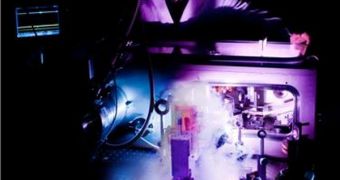The link between mass and acceleration is clear to anyone. The mass of a body and the force that acts on it determine how fast that particular object will travel when the force is applied. Given a force of a specified value, a lighter object will always be accelerated faster than a heavier one, for the simple reason that more force is needed to get the latter rolling. In other words, the inertial mass of the object is the ratio between force and acceleration. In a new study, German investigators made some interesting finds about how some elementary particles behave under this rule, AlphaGalileo reports.
Experts from the Max Born Institute, in Berlin, conducted a series of experiments meant to gage the behavior of a particular type of electrons. They looked at elementary particles trapped inside semiconductor crystals, which were accelerated with high energies, inside a very powerful electric field. They learned that these particular electrons behaved quite differently than the theory suggested and say that analysis of the results point to the fact that these particles have a negative inertial mass. Details of their investigation appear in the current issue of the esteem journal Physical Review Letters.
In their experiments, the MBI team managed to devise a setup in which crystal electrons were accelerated to speeds exceeding 4 million kilometers per hour in just 100 femtoseconds. A femtosecond is one of the smallest units of time ever devised, equal to one quadrillionth, or one millionth of a billionth of a second. Working at this extremely precise level, the team noticed that the electrons they were watching even took on a negative inertial mass. This was made obvious by the fact that, as soon as the electrons were stopped, they began moving backwards.
This means that the acceleration they were subjected to was directed opposite to the force, which is something that does not occur according to Sir Isaac Newton's original 17th-century theory. The observations the team made can only be explained through such a negative mass. Nobel Prize winner Felix Bloch first proposed that this would happen under the circumstance more than 80 years ago, but he did not have the modern technology available today at his disposal, to conduct verifications of his hypothesis. The electrical field the German team used had a strength of 30 million Volts per meter.

 14 DAY TRIAL //
14 DAY TRIAL //